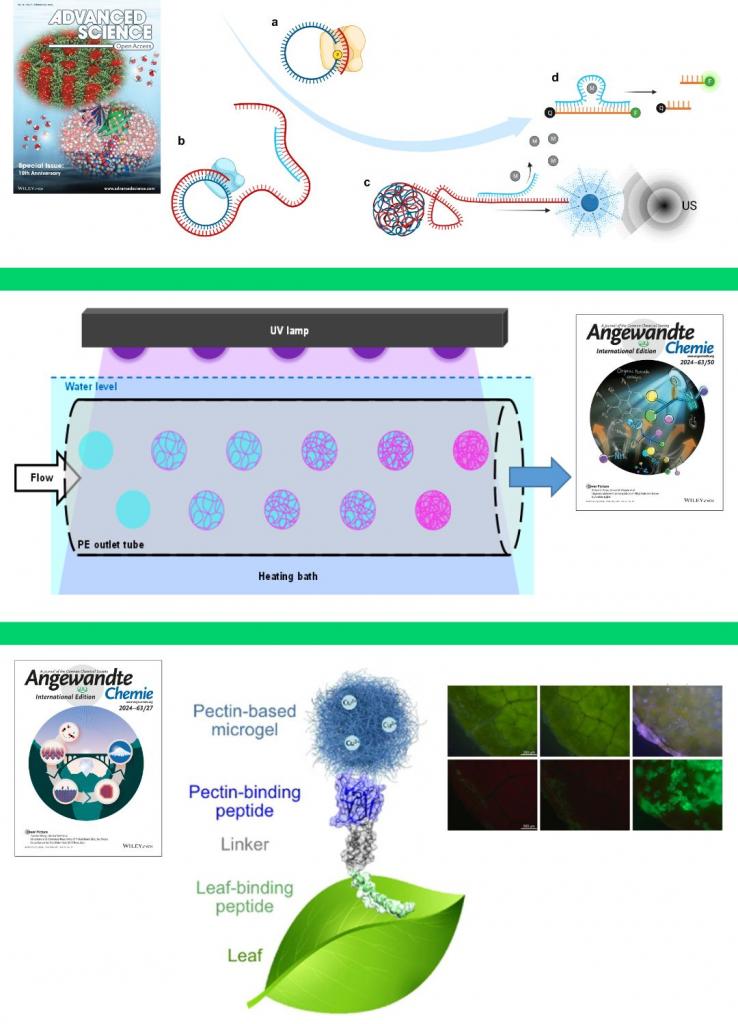The Year in Review: Must-Read DWI Publications from 2024

As the year comes to a close and the festive season draws near, it’s the perfect time to pause and reflect.
We’d like to take this moment to share some remarkable publications from this year — insightful reads that might inspire you and spark new ideas. So why not take a break, grab your favorite hot drink, and explore the first part our curated selection?
𝗠𝗲𝗰𝗵𝗮𝗻𝗼𝗰𝗵𝗲𝗺𝗶𝗰𝗮𝗹 𝗮𝗰𝘁𝗶𝘃𝗮𝘁𝗶𝗼𝗻 𝗼𝗳 𝗗𝗡𝗔𝘇𝘆𝗺𝗲𝘀 𝘄𝗶𝘁𝗵 𝘂𝗹𝘁𝗿𝗮𝘀𝗼𝘂𝗻𝗱:
Wolfgang Rath, Robert Göstl and Andreas Herrmann demonstrate in this paper, published in Advanced Science, the mechanochemical activation of an RNA-cleaving DNAzyme using ultrasound. Their approach is envisioned to improve the control over DNAzyme activity for the development of reliable and specific sensing applications. This is the first time that this release mechanism is applied for the activation of catalytic nucleic acids, and it has multiple advantages over other stimuli.
𝗠𝗶𝗰𝗿𝗼𝗴𝗲𝗹 𝗯𝘂𝗶𝗹𝗱𝗶𝗻𝗴 𝗯𝗹𝗼𝗰𝗸𝘀 𝗳𝗼𝗿 𝗶𝗻 𝘃𝗶𝘁𝗿𝗼 𝗴𝘆𝗺:
This work, published by our colleagues of the De Laporte group (in Angew. Chem. Int. Ed.) describes a new method to produce thermoresponsive microgels with defined mechanical properties, surface morphologies, and volume phase transition temperatures.
It holds high potential to create soft and dynamic materials while maintaining the chemical composition for a wide variety of applications in biomedicine.
𝗕𝗶𝗼-𝗯𝗮𝘀𝗲𝗱 𝗮𝗻𝗱 𝘀𝘂𝗿𝗳𝗮𝗰𝗲-𝗳𝘂𝗻𝗰𝘁𝗶𝗼𝗻𝗮𝗹𝗶𝘇𝗲𝗱 𝗺𝗶𝗰𝗿𝗼𝗴𝗲𝗹𝘀 𝗮𝘀 𝗮 𝘀𝘂𝘀𝘁𝗮𝗶𝗻𝗮𝗯𝗹𝗲 𝗽𝗲𝘀𝘁𝗶𝗰𝗶𝗱𝗲 𝗱𝗲𝗹𝗶𝘃𝗲𝗿𝘆 𝘀𝘆𝘀𝘁𝗲𝗺
The scientists from the working groups of Ulrich Schwaneberg and Andrij Pich have further developed their plant protection system: In Angew. Chem. Int. Ed., they show a bio-based and biodegradable pesticide delivery system based on pectin microgels.
Due to the inherent properties of pectin, the microgel containers can be loaded with Cu2+ as the active substance and bound to vine leaves in a rainproof manner by decorating them with biadhesive anchor peptides.
Under semi-outdoor conditions, the developed pesticide delivery system effectively prevented downy mildew infection of grapevine vines.
